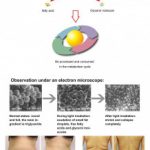Last Updated on 1 year by Francis
Psoriasis is a chronic autoimmune disorder that affects the skin. It is characterized by red, scaly patches that can be itchy and painful. While there is currently no cure for psoriasis, there are several treatment options available, including light therapy. Light therapy, also known as phototherapy, involves exposing the skin to specific wavelengths of light to reduce inflammation and promote healing. But what color light therapy is best for psoriasis? In this article, we will explore the different options and help you determine which one may be right for you.
Psoriasis is a chronic autoimmune disease that affects the skin, causing red, scaly patches to form. One treatment option for psoriasis is light therapy, which uses ultraviolet (UV) radiation to slow down the growth of skin cells. However, not all types of light therapy are the same. In this discussion, we will focus on the use of color light therapy for psoriasis and its potential benefits.
Contents
Understanding Psoriasis
Before we dive into light therapy, it’s important to understand psoriasis and how it affects the skin. Psoriasis is caused by an overactive immune system that triggers an inflammatory response in the skin. This inflammation leads to the development of red, scaly patches that can be itchy and painful. Psoriasis can affect any part of the body, but it is most commonly found on the scalp, elbows, knees, and lower back.
How Does Light Therapy Work?
Light therapy works by exposing the skin to specific wavelengths of light that penetrate the skin and reduce inflammation. The two most common types of light therapy used to treat psoriasis are narrowband UVB and PUVA therapy. Narrowband UVB therapy uses a specific wavelength of UVB light, while PUVA therapy uses a combination of psoralen (a medication that makes the skin more sensitive to light) and UVA light.
Narrowband UVB Therapy
Narrowband UVB therapy is the most commonly used type of light therapy for psoriasis. It uses a specific wavelength of UVB light (311-312 nm) that has been shown to be the most effective in treating psoriasis. During the treatment, the patient stands in a light booth or uses a handheld UVB wand. The exposure time is gradually increased over several weeks until the psoriasis clears up.
PUVA Therapy
PUVA therapy involves taking a medication called psoralen, which makes the skin more sensitive to light. The patient then stands in a light booth or uses a handheld UVA wand. The UVA light penetrates the skin and activates the psoralen, which helps to reduce inflammation and promote healing. PUVA therapy is typically reserved for patients with severe psoriasis or those who have not responded to other treatments.
While narrowband UVB and PUVA therapy are the most commonly used types of light therapy for psoriasis, other types of light therapy may also be effective. One of these is blue light therapy.
Blue Light Therapy
Blue light therapy uses a specific wavelength of blue light (around 453 nm) to reduce inflammation and promote healing in the skin. While blue light therapy is not as commonly used for psoriasis as narrowband UVB and PUVA therapy, some studies have shown that it may be effective in treating mild to moderate psoriasis.
Red Light Therapy
Red light therapy uses a specific wavelength of red light (around 633 nm) to reduce inflammation and promote healing in the skin. While red light therapy has been shown to be effective in treating other skin conditions, such as acne and rosacea, there is currently limited research on its effectiveness in treating psoriasis.
Green Light Therapy
Green light therapy uses a specific wavelength of green light (around 525 nm) to reduce inflammation and promote healing in the skin. While there is limited research on the effectiveness of green light therapy in treating psoriasis, some studies have shown that it may be effective in reducing itching and inflammation.
FAQs for What Color Light Therapy for Psoriasis
What is light therapy for psoriasis?
Light therapy, also known as phototherapy, is the use of ultraviolet (UV) light to treat various skin conditions, including psoriasis. The therapy involves exposing your skin to artificial or natural light for a specific amount of time.
What colors of light are used in light therapy for psoriasis?
The most common colors of light used in light therapy for psoriasis are UVB (ultraviolet B) and UVA (ultraviolet A). UVB light penetrates the upper layers of the skin to slow down the production of skin cells, which is helpful in treating psoriasis. UVA light penetrates deeper into the skin than UVB and is best used in combination with a photosensitizing agent.
Is red light therapy effective for psoriasis?
Red light therapy is not commonly used to treat psoriasis. While it has shown some effectiveness in treating other skin conditions, such as acne and rosacea, there is limited evidence to support its use in treating psoriasis.
Can blue light therapy be used for psoriasis?
Blue light therapy is also not commonly used to treat psoriasis. While it has shown some effectiveness in treating other skin conditions, such as eczema and contact dermatitis, there is limited evidence to support its use in treating psoriasis.
Does light therapy have any side effects?
Like all treatments, light therapy does have potential side effects. The most common side effects of light therapy for psoriasis include redness, itching, and dryness of the skin. Additionally, long-term exposure to UV light can increase the risk of skin cancer. Therefore, it is important to work with a healthcare professional to ensure proper dosing and monitoring during light therapy treatments.
How long does it take before I see results from light therapy for psoriasis?
The amount of time it takes to see results from light therapy for psoriasis varies depending on the severity of the condition and the type of light therapy used. Generally, it can take several weeks of consistent treatments before improvement is seen. It is important to note that light therapy should be used in conjunction with other treatments for psoriasis to achieve the best results.

.jpg)






